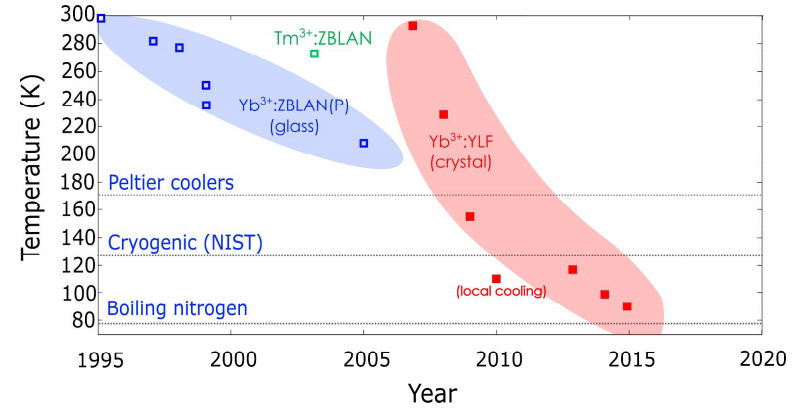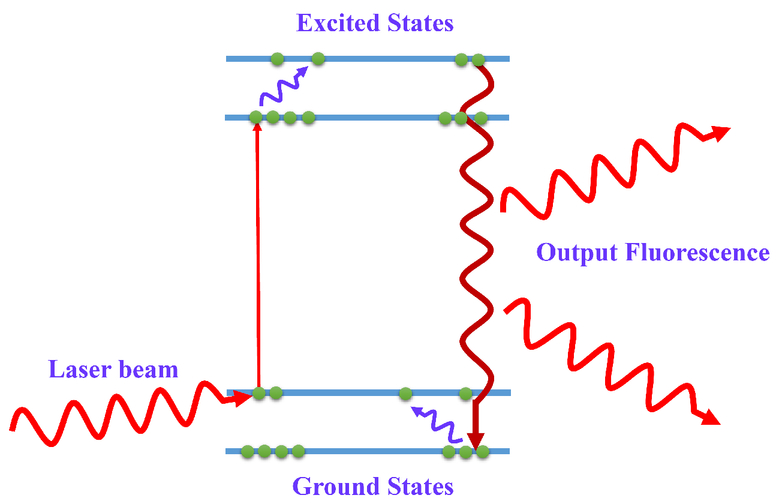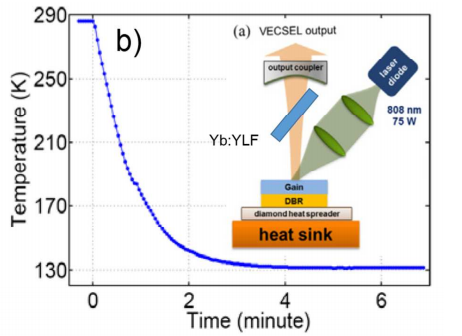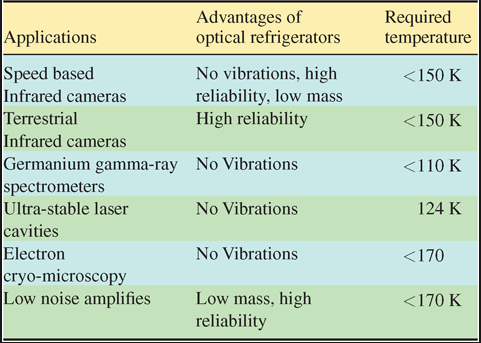Low temperature physics has helped us produce exotic quantum materials such as superconductors. This usually requires cryogenic fluids such as liquid nitrogen and helium for operation. Recently cooling systems with lasers have been explored for alternative routes to attain low temperatures. Laser cooling has been used to slow down atoms to create “cold atoms”. This has opened up the field of cold atom physics for testing many fundamental ideas in physics. Apart from cooling atoms, cooling solids using lasers can increase the reliability of certain systems that have a poor performance at higher temperatures.
Laser cooling of solids was first demonstrated in 1995 with Ytterbium doped fluoride glass. This led to a flurry of research activity to show cooling in rare-earth doped materials, with temperatures as low as 80 K. This is very attractive for maintaining low temperatures, as laser cooling can be cheaper than using liquid coolant systems, and does not have moving parts or fluids for operation.
In this article, cooling mechanisms in rare-earth doped solids is discussed, with the possible problems in others to be overcome. Optomechanical cooling in nanosystems is also discussed.
Since the first demonstration of laser cooling of solids in 1995, people have demonstrated many solids that can be cooled with temperatures as low as 80 K over time. Most of the effective systems have been rare-earth doped crystals and glasses. The timeline of the discoveries is outlined in the below image.

Timeline for rare-earth based cooling. Doped crystals and glass are used for cooling. Courtesy of IOP.
Physics of Laser Cooling
The physics of laser cooling in solids uses the phenomena of anti-Stokes fluorescence. This involves light taking away the thermal energy from the system. In solids, the population of vibrational modes by phonons gives rise to the system’s temperature. Removing the phonons in the high energy modes can lower the temperature of the system. In anti-Stokes fluorescence, the incoming light of lower energy excites the electronic state of the system. The system then absorbs phonons and fluoresces at a higher energy. This takes away the phonons in the system away as light energy.

Anti-stokes fluorescence: Blue wiggles indicate phonon absorption. Output light is at a higher energy than the input light.
Rare-Earth based Cooling
Rare earth doped materials are efficient in this process, because non-radiative recombination is suppressed. Rare-earth elements are known for their electrons in the 4f orbitals being shielded by electrons in the outer orbitals. This suppresses the coupling between the 4f electronic states and the crystal vibrations, hence limiting the ability to emit phonons easily. The efficiency of absorbing phonons increases however by using the incident pump energy lower than the mean fluorescence energy. This way, the process is favorable for phonon extraction, rather than phonon emission. Using this laser cooling, Ytterbium doped fluoride glass has been cooled to 130 K. The setup for the cooling system is shown below. A diode laser tuned to 808 nm is used for this purpose.

RE based cooling: Here a surface emitting diode laser is used as input beam. Ytterbium doped fluoride glass is the solid cooled. Moderate cooling to 130 K is observed. Courtesy of IOP.
Optomechanical Cooling
Laser cooling in solids has also been explored in the nanoscale dimensions, which is referred to as optomechanical cooling. The setup for a optomechanical cooling system is shown below.

Optomechanical cooling: a) System setup. b) The thermodynamic process in a single oscillation. c) Detuning between the cavity mode and the incoming laser beam. Courtesy of Modern Optics.
The setup usually involves a cavity with one mirror being a mechanical oscillator. The aim of cooling is to bring the mechanical oscillator to its lowest ground state, which is the smallest possible vibrational mode. The incoming laser beam is slightly red-shifted than the mean optical resonance frequency. The laser beam gives rise to a radiation pressure on the mechanical oscillator. When the oscillator moves towards the light beam, light does work on the system. Conversely, as the oscillator moves back again in the second half of the cycle, the light extracts energy and it is larger than energy lost in the first half. In total, light takes away energy from the oscillator, cooling the mechanical system.
Future of Laser Cooling
Laser cooling in semiconductors is being explored for the future. Cooling in semiconductors still involves taking away phonons from the system, but the process is not as efficient as rare-earth doped materials. Check out the review for approaches in semiconductor cooling taken so far. Cooling in semiconductors can increase reliability of certain electronic systems. For example, imaging and spectroscopic systems have a better performance and lifetime as thermal vibrations are reduced.

Advantages of laser cooling. The benefits come from reduced vibrations, and increased reliability. Courtesy of IOP.
Check out Findlight’s collection of solid state lasers and laser crystals used for cooling in rare-earth doped systems.

Professor Prem raj Pushpakaran writes — 2022 marks the birth centenary year of Hans Georg Dehmelt!!!